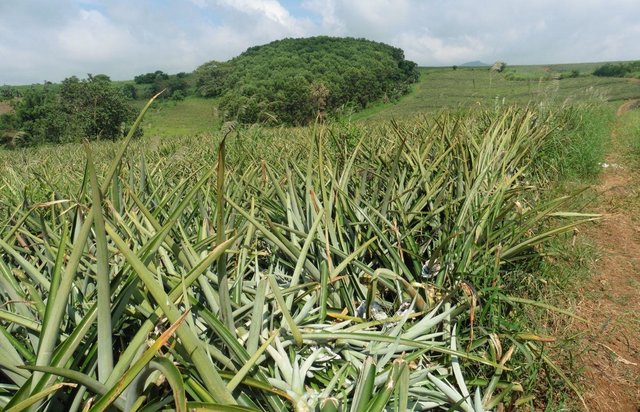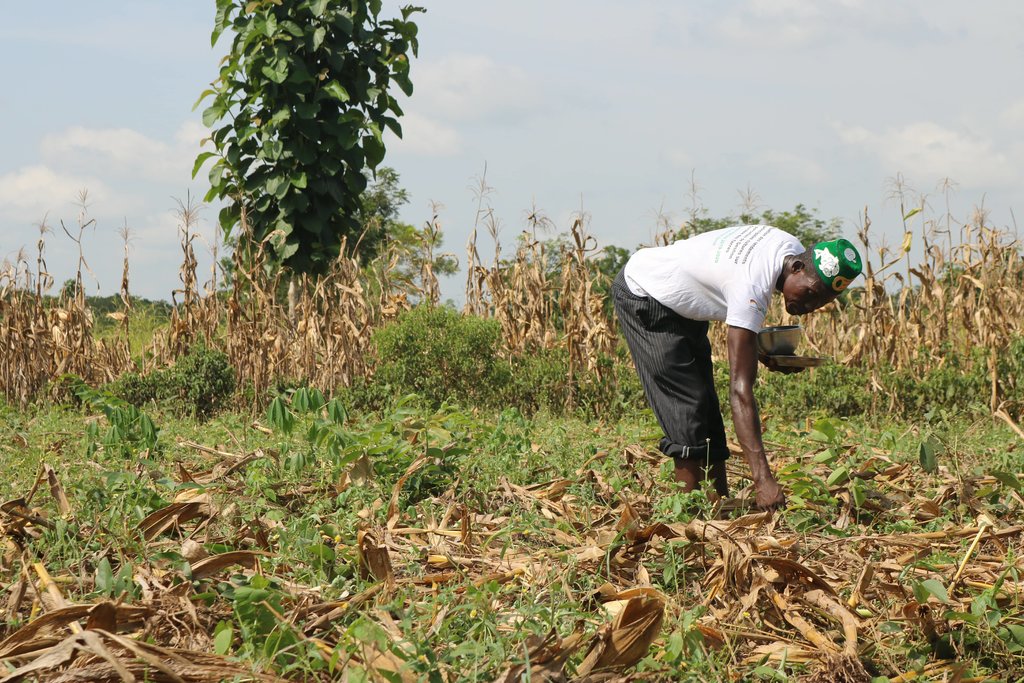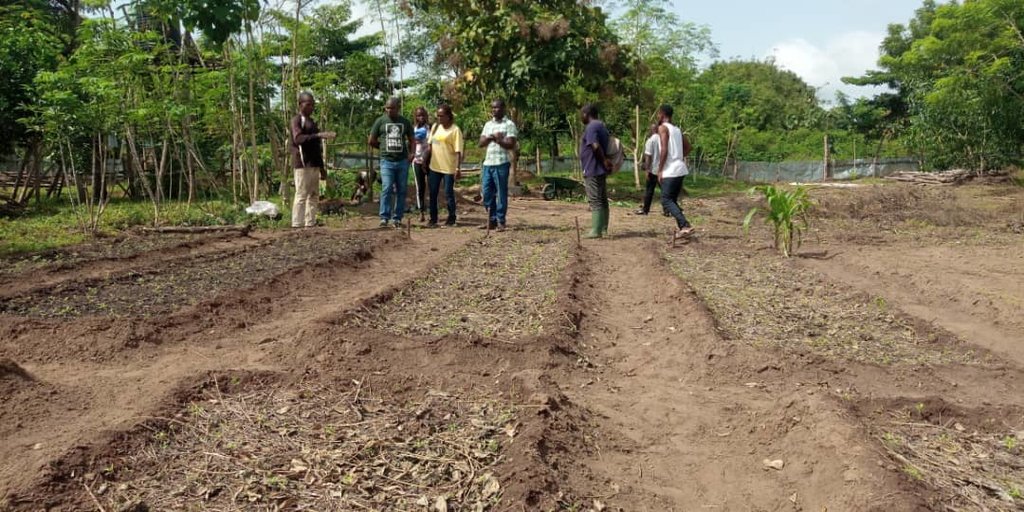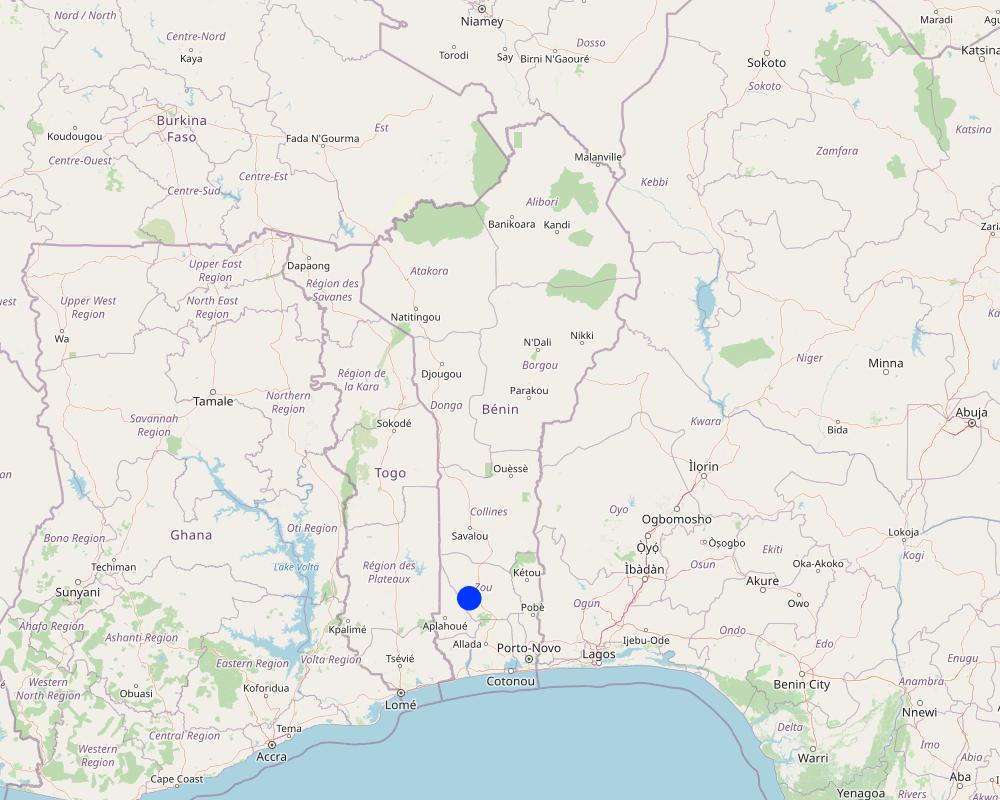Mulching and Cover Cropping [Benin]
- Creation:
- Update:
- Compiler: Gatien AGBOKOUN CHRISTOPHE
- Editors: Siagbé Golli, Tchorouwé Ezéchiel N'YABA, Tabitha Nekesa, Ahmadou Gaye
- Reviewers: Sally Bunning, Rima Mekdaschi Studer, William Critchley
Gbéditè
technologies_6664 - Benin
View sections
Expand all Collapse all1. General information
1.2 Contact details of resource persons and institutions involved in the assessment and documentation of the Technology
Key resource person(s)
land user:
GBONONGBA Paulin
ALDIPE
Benin
land user:
KANLISSOU Rigobert
ALDIPE
Benin
SLM specialist:
AHIDEHOU Rodrigue
ALDIPE
Benin
Name of project which facilitated the documentation/ evaluation of the Technology (if relevant)
Soil protection and rehabilitation for food security (ProSo(i)l)Name of the institution(s) which facilitated the documentation/ evaluation of the Technology (if relevant)
GIZ Bénin (GIZ Bénin) - Benin1.3 Conditions regarding the use of data documented through WOCAT
The compiler and key resource person(s) accept the conditions regarding the use of data documented through WOCAT:
Yes
1.4 Declaration on sustainability of the described Technology
Is the Technology described here problematic with regard to land degradation, so that it cannot be declared a sustainable land management technology?
No
1.5 Reference to Questionnaire(s) on SLM Approaches (documented using WOCAT)

Integrated Soil and Water Conservation Approach in Improving … [Philippines]
Integration of soil and water conservation technologies primarily aim to protect the area from loss of biodiversity and land degradation.
- Compiler: Philippine Overview of Conservation Approaches and Technologies
2. Description of the SLM Technology
2.1 Short description of the Technology
Definition of the Technology:
Mulching is the practice of spreading non-living organic matter - such as crop residues - onto the soil for its protection and improvement while cover cropping is the planting of a legume species such as mucuna which protects the soil surface and fixes nitrogen,
2.2 Detailed description of the Technology
Description:
Mulching and cover cropping are techniques associated with conservation agriculture. With the exception of soils subject to flooding, these techniques find applicability across various types of soil (especially bare and crusted degraded soils). ProSOL-supported producers apply it mainly on flat soils.
(1) Mulch originates from crops whose residues are collected and spread over a specific area. The crop depends on the producer's activity, whether it involves market gardening or annual cropping. In the case of market gardening, palm branches can be used in nurseries, while soybean residues obtained after threshing can be used in market gardening beds.
Producers engaged in annual cropping utilise the biomass generated by their crops for mulching. In this scenario, the mulch is created by accumulating piles of land-clearing residues in the field during the soil preparation phase. Producers also add bulky tree branches and stems and spread them over the soil to form a thick layer. In addition, they sometimes mow areas not intended for cultivation during the season and spread the cuttings as mulch. This practice is what has earned the technique its "crazy work" name.
Mulching offers various advantages, including:
•maintenance of soil moisture;
•proliferation and feeding of living organisms in the soil;
•increased soil porosity;
•reduced erosion effects;
•better development and growth of crops; and
•suppression of weeds and undesirable species competing with crops
To ensure sustainability and scalability, producers establish firebreaks to avert mulch combustion. They also monitor their plots to forestall grazing by wandering or transhumant animals.
Market gardeners employing this technique report a decrease in mineral fertilizer usage (by a third to a half) and an enhancement in the quality of harvested produce. Similarly, farmers utilizing it for annual cropping purposes witnessed a significant boost in yields, especially for cowpeas (an improvement of approximately three times the yield).
(2) Cover cropping is implemented by planting a herbaceous legume, for example mucuna to a specific area. The biomass obtained from this application serves as a living soil cover while it simultaneously fixes nitrogen from the atmosphere.
2.3 Photos of the Technology
2.5 Country/ region/ locations where the Technology has been applied and which are covered by this assessment
Country:
Benin
Region/ State/ Province:
Abomey
Specify the spread of the Technology:
- evenly spread over an area
Is/are the technology site(s) located in a permanently protected area?
No
Map
×2.6 Date of implementation
Indicate year of implementation:
2016
2.7 Introduction of the Technology
Specify how the Technology was introduced:
- through projects/ external interventions
Comments (type of project, etc.):
ProSOL/GIZ: Soil Rehabilitation and Restoration Project financed by the German Cooperation Agency
3. Classification of the SLM Technology
3.1 Main purpose(s) of the Technology
- improve production
- reduce, prevent, restore land degradation
- preserve/ improve biodiversity
- adapt to climate change/ extremes and its impacts
- create beneficial economic impact
3.2 Current land use type(s) where the Technology is applied
Land use mixed within the same land unit:
No

Cropland
- Annual cropping
Annual cropping - Specify crops:
- cereals - maize
- cereals - other
- fibre crops - cotton
- vegetables - leafy vegetables (salads, cabbage, spinach, other)
- vegetables - root vegetables (carrots, onions, beet, other)
Number of growing seasons per year:
- 1
Is intercropping practiced?
No
Is crop rotation practiced?
Yes
If yes, specify:
Market gardeners rotate their crops.
3.3 Has land use changed due to the implementation of the Technology?
Has land use changed due to the implementation of the Technology?
- Yes (Please fill out the questions below with regard to the land use before implementation of the Technology)
Land use mixed within the same land unit:
No

Cropland
- Annual cropping
Annual cropping - Specify crops:
- cereals - maize
- vegetables - leafy vegetables (salads, cabbage, spinach, other)
- vegetables - root vegetables (carrots, onions, beet, other)
Is intercropping practiced?
Yes
3.4 Water supply
Water supply for the land on which the Technology is applied:
- mixed rainfed-irrigated
Comments:
Rainwater for annual crops and irrigated water for market gardening crops.
3.5 SLM group to which the Technology belongs
- improved ground/ vegetation cover
- integrated soil fertility management
3.6 SLM measures comprising the Technology

agronomic measures
- A1: Vegetation/ soil cover
- A2: Organic matter/ soil fertility
- A6: Residue management
A6: Specify residue management:
A 6.4: retained

management measures
- M6: Waste management (recycling, re-use or reduce)
3.7 Main types of land degradation addressed by the Technology

soil erosion by water
- Wt: loss of topsoil/ surface erosion

soil erosion by wind
- Et: loss of topsoil

chemical soil deterioration
- Cn: fertility decline and reduced organic matter content (not caused by erosion)

biological degradation
- Bc: reduction of vegetation cover
- Bh: loss of habitats
- Bl: loss of soil life
3.8 Prevention, reduction, or restoration of land degradation
Specify the goal of the Technology with regard to land degradation:
- reduce land degradation
4. Technical specifications, implementation activities, inputs, and costs
4.1 Technical drawing of the Technology
Technical specifications (related to technical drawing):
Increased straw cover leads to more effective protection and reduced disturbance.
Reducing soil tillage increases residue cover, and maintaining soil integrity slows down the loss of organic matter and degradation of soil structure. The recommended mulching rate is between 1.5 to 2 tons per hectare (equivalent to 2 to 3 stalks per square meter or 150 to 200 grams of stalks per square meter). Stalks should be distributed on the ground promptly after harvesting (October to November).
It is recommended to leave stumps in place for as long as possible. After the cobs have been removed, the stalks can be added to complete the mulch.
4.2 General information regarding the calculation of inputs and costs
Specify how costs and inputs were calculated:
- per Technology area
Indicate size and area unit:
1 kanti
If using a local area unit, indicate conversion factor to one hectare (e.g. 1 ha = 2.47 acres): 1 ha =:
400 square meters
other/ national currency (specify):
CFA F
If relevant, indicate exchange rate from USD to local currency (e.g. 1 USD = 79.9 Brazilian Real): 1 USD =:
619.68
Indicate average wage cost of hired labour per day:
2000
4.3 Establishment activities
| Activity | Timing (season) | |
|---|---|---|
| 1. | Stalk mowing (when mulch is made from stalks of millet, sorghum, etc.) | January-March |
| 2. | Mulching | February-March |
| 3. | Seedling | April |
| 4. | Maintenance | May |
| 5. | Harvest | June-July |
4.4 Costs and inputs needed for establishment
| Specify input | Unit | Quantity | Costs per Unit | Total costs per input | % of costs borne by land users | |
|---|---|---|---|---|---|---|
| Labour | Stalk mowing (when mulch is made from stalks of millet, sorghum, etc.) | kanti | 1.0 | 1250.0 | 1250.0 | 100.0 |
| Labour | Mulching | kanti | 1.0 | 2500.0 | 2500.0 | 100.0 |
| Labour | Seedling | kanti | 1.0 | 700.0 | 700.0 | 100.0 |
| Labour | Maintenance | Kanti | 1.0 | 500.0 | 500.0 | 100.0 |
| Plant material | Straws | Kanti | 1.0 | 1250.0 | 1250.0 | 100.0 |
| Total costs for establishment of the Technology | 6200.0 | |||||
| Total costs for establishment of the Technology in USD | 10.01 | |||||
4.5 Maintenance/ recurrent activities
| Activity | Timing/ frequency | |
|---|---|---|
| 1. | Firebreak installation | January |
| 2. | Mulching | May-June |
4.6 Costs and inputs needed for maintenance/ recurrent activities (per year)
| Specify input | Unit | Quantity | Costs per Unit | Total costs per input | % of costs borne by land users | |
|---|---|---|---|---|---|---|
| Labour | Firebreak installation | kanti | 1.0 | 1000.0 | 1000.0 | 100.0 |
| Labour | Mulching | kanti | 1.0 | 1500.0 | 1500.0 | 100.0 |
| Total costs for maintenance of the Technology | 2500.0 | |||||
| Total costs for maintenance of the Technology in USD | 4.03 | |||||
4.7 Most important factors affecting the costs
Describe the most determinate factors affecting the costs:
Searching for straw when farmers want to grow vegetables on a large scale
5. Natural and human environment
5.1 Climate
Annual rainfall
- < 250 mm
- 251-500 mm
- 501-750 mm
- 751-1,000 mm
- 1,001-1,500 mm
- 1,501-2,000 mm
- 2,001-3,000 mm
- 3,001-4,000 mm
- > 4,000 mm
Specify average annual rainfall (if known), in mm:
1003.00
Agro-climatic zone
- humid
Abomey-Calavi is characterized by a tropical climate.
5.2 Topography
Slopes on average:
- flat (0-2%)
- gentle (3-5%)
- moderate (6-10%)
- rolling (11-15%)
- hilly (16-30%)
- steep (31-60%)
- very steep (>60%)
Landforms:
- plateau/plains
- ridges
- mountain slopes
- hill slopes
- footslopes
- valley floors
Altitudinal zone:
- 0-100 m a.s.l.
- 101-500 m a.s.l.
- 501-1,000 m a.s.l.
- 1,001-1,500 m a.s.l.
- 1,501-2,000 m a.s.l.
- 2,001-2,500 m a.s.l.
- 2,501-3,000 m a.s.l.
- 3,001-4,000 m a.s.l.
- > 4,000 m a.s.l.
Indicate if the Technology is specifically applied in:
- not relevant
5.3 Soils
Soil depth on average:
- very shallow (0-20 cm)
- shallow (21-50 cm)
- moderately deep (51-80 cm)
- deep (81-120 cm)
- very deep (> 120 cm)
Soil texture (topsoil):
- coarse/ light (sandy)
- fine/ heavy (clay)
Soil texture (> 20 cm below surface):
- coarse/ light (sandy)
- fine/ heavy (clay)
Topsoil organic matter:
- high (>3%)
5.4 Water availability and quality
Ground water table:
5-50 m
Availability of surface water:
poor/ none
Water quality (untreated):
good drinking water
Water quality refers to:
ground water
Is water salinity a problem?
No
Is flooding of the area occurring?
No
5.5 Biodiversity
Species diversity:
- medium
Habitat diversity:
- medium
5.6 Characteristics of land users applying the Technology
Sedentary or nomadic:
- Sedentary
Market orientation of production system:
- mixed (subsistence/ commercial)
Off-farm income:
- less than 10% of all income
Relative level of wealth:
- poor
Individuals or groups:
- individual/ household
Level of mechanization:
- manual work
Gender:
- women
- men
Age of land users:
- youth
- middle-aged
5.7 Average area of land used by land users applying the Technology
- < 0.5 ha
- 0.5-1 ha
- 1-2 ha
- 2-5 ha
- 5-15 ha
- 15-50 ha
- 50-100 ha
- 100-500 ha
- 500-1,000 ha
- 1,000-10,000 ha
- > 10,000 ha
Is this considered small-, medium- or large-scale (referring to local context)?
- small-scale
5.8 Land ownership, land use rights, and water use rights
Land ownership:
- group
- individual, not titled
Land use rights:
- communal (organized)
- individual
Water use rights:
- communal (organized)
Are land use rights based on a traditional legal system?
Yes
Specify:
The lands are owned by local authorities.
5.9 Access to services and infrastructure
health:
- poor
- moderate
- good
education:
- poor
- moderate
- good
technical assistance:
- poor
- moderate
- good
employment (e.g. off-farm):
- poor
- moderate
- good
markets:
- poor
- moderate
- good
energy:
- poor
- moderate
- good
roads and transport:
- poor
- moderate
- good
drinking water and sanitation:
- poor
- moderate
- good
financial services:
- poor
- moderate
- good
6. Impacts and concluding statements
6.1 On-site impacts the Technology has shown
Socio-economic impacts
Production
crop production
Quantity before SLM:
1.2 ton
Quantity after SLM:
2.5 to 3 tons
Comments/ specify:
Mulching contributes to improved agricultural production by supporting microbial life in the soil, protecting the soil from rain-induced erosion, promoting water infiltration, and providing a suitable environment for crop growth by maintaining soil fertility and health.
crop quality
Comments/ specify:
Market garden cropping has improved.
product diversity
Comments/ specify:
Mulches facilitate crop rotation.
production area
land management
Income and costs
expenses on agricultural inputs
Comments/ specify:
Mulches reduce the need for chemical fertilizers, especially in market gardening.
workload
Comments/ specify:
Mulching contributes considerably to reducing weed proliferation and the use of herbicides.
Socio-cultural impacts
food security/ self-sufficiency
health situation
Comments/ specify:
Limiting the use of pesticides significantly contributes to enhancing product quality and, consequently, positively impacts health conditions.
recreational opportunities
Comments/ specify:
As harvests improve, producers gain more income and can afford some recreational activities.
SLM/ land degradation knowledge
Ecological impacts
Water cycle/ runoff
evaporation
Quantity before SLM:
2 compulsory waterings per day per bed without mulch
Quantity after SLM:
1 watering on average per day is sufficient.
Comments/ specify:
Considerably reduces evapotranspiration.
Soil
soil moisture
soil cover
Comments/ specify:
Reduces weeds and facilitates field maintenance
soil organic matter/ below ground C
Biodiversity: vegetation, animals
biomass/ above ground C
invasive alien species
pest/ disease control
Climate and disaster risk reduction
drought impacts
micro-climate
6.3 Exposure and sensitivity of the Technology to gradual climate change and climate-related extremes/ disasters (as perceived by land users)
Gradual climate change
Gradual climate change
| Season | increase or decrease | How does the Technology cope with it? | |
|---|---|---|---|
| annual temperature | increase | well | |
| seasonal temperature | dry season | increase | moderately |
| annual rainfall | decrease | moderately | |
| seasonal rainfall | dry season | increase | moderately |
Climate-related extremes (disasters)
Climatological disasters
| How does the Technology cope with it? | |
|---|---|
| drought | moderately |
6.4 Cost-benefit analysis
How do the benefits compare with the establishment costs (from land users’ perspective)?
Short-term returns:
positive
Long-term returns:
slightly positive
How do the benefits compare with the maintenance/ recurrent costs (from land users' perspective)?
Short-term returns:
very positive
Long-term returns:
positive
6.5 Adoption of the Technology
- 11-50%
Of all those who have adopted the Technology, how many did so spontaneously, i.e. without receiving any material incentives/ payments?
- 0-10%
6.6 Adaptation
Has the Technology been modified recently to adapt to changing conditions?
No
6.7 Strengths/ advantages/ opportunities of the Technology
| Strengths/ advantages/ opportunities in the land user’s view |
|---|
| Increased crop yields |
| Water- and wind-induced loss of fine soil particles |
| Protection of farmlands against wind- and/or water-induced erosion |
| Strengths/ advantages/ opportunities in the compiler’s or other key resource person’s view |
|---|
| High nitrogen fixation capacity |
| Conservation of biodiversity in the soil |
| Slowing down the erosion process |
| Facilitating the growth of living soil organisms |
6.8 Weaknesses/ disadvantages/ risks of the Technology and ways of overcoming them
| Weaknesses/ disadvantages/ risks in the land user’s view | How can they be overcome? |
|---|---|
| Termite attraction in the second year | Utilization of insecticides and fungicides as soon as crops are established |
| Difficulties in finding straw in sufficient quantities | Development of pure mucuna cultivation |
| Weaknesses/ disadvantages/ risks in the compiler’s or other key resource person’s view | How can they be overcome? |
|---|---|
| Attraction of reptiles (snakes, scorpions, etc.) | Wear boots and gloves during work |
| Difficulties in finding labor for spreading activities | Use and incentivize family labor |
7. References and links
7.1 Methods/ sources of information
- field visits, field surveys
2
- interviews with land users
2
- interviews with SLM specialists/ experts
2
- compilation from reports and other existing documentation
6
When were the data compiled (in the field)?
01/16/2023
7.2 References to available publications
Title, author, year, ISBN:
Deutsche Gesellschaft für Internationale Zusammenarbeit (GIZ) GmbH, 2018. Compendium de fiches techniques du formateur,
7.3 Links to relevant online information
Title/ description:
Resettlement Action Plan
URL:
https://www.afdb.org/sites/default/files/5.-papvs_rapport-par_abomey.pdf
Title/ description:
Monograph of the Commune of Abomey
URL:
https://docplayer.fr/40817641-Monographie-de-la-commune-d-abomey.html
Title/ description:
The climate of the city of Abomey
URL:
https://fr.weatherspark.com/y/45798/M%C3%A9t%C3%A9o-moyenne-%C3%A0-Abomey-B%C3%A9nin-tout-au-long-de-l'ann%C3%A9e
Title/ description:
PAILLAGE, UNEP Copenhagen Climate Centre
URL:
https://tech-action.unepccc.org/wp-content/uploads/sites/2/2022/05/benin-np-adaptation-paillage.pdf
Title/ description:
Promotion des systèmes de semis direct sous couverture végétale au Bénin : état des lieux,, travaux de terrain et perspectives
URL:
http://open-library.cirad.fr/files/2/219__1188720984.pdf
Links and modules
Expand all Collapse allLinks

Integrated Soil and Water Conservation Approach in Improving … [Philippines]
Integration of soil and water conservation technologies primarily aim to protect the area from loss of biodiversity and land degradation.
- Compiler: Philippine Overview of Conservation Approaches and Technologies
Modules
No modules






